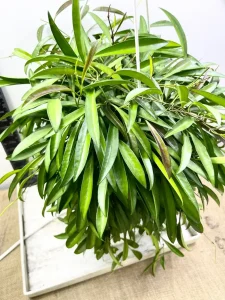The Hoya Wayetii Green is a climber plant belonging to the Hoya genus and Dogbane (Apocynaceae) family. With 500+ accepted species in the genus, Hoyas are native to tropical Asian countries such as the Philippines and India.
Hoya Wayetiis make beautiful indoor flowering plants with lush trailing vines and leaves. When in bloom, the shiny, fragrant, and wax-like Hoya flower smells like butterscotch. This makes them great indoor houseplants.
Hoya Wayetii Green Care
Wayetiis require maintenance and attention to maintain their healthy appearance and bloom.
Below, you’ll find everything you need about caring for Wayetiis, from soil to watering, lighting, humidity, and everything in between.
Soil
Wayetiis are epiphytes, meaning they attach themselves to trees in the wild. Therefore, it is best to plant them in a loose soil mix that drains well. Avoid nursery soils as they are often peat-heavy and cannot properly drain.
For optimal growth, we recommend fast-draining potting mix soil (or even cactus soil) high in minerals such as perlite and vermiculite. Add in coconut chunks, orchid bark, or even a little activated charcoal to help aerate and dry the soil. Avoid burying the plant too deep into the soil, as Wayetiis require plenty of air around their roots.
Watering
Owners tend to overwater their Wayetiis, causing them to be waterlogged.
To avoid this, let the topsoil of your plant completely dry out before watering. You can place a finger or dowel two inches into the soil to test for moisture.
When watering, fill until water escapes from the bottom of the pot, then allow water to drain before putting it back in its original location. Use distilled water whenever possible to avoid unwanted chemicals from tap water.
Lighting
Wayetiis are high-hanging, potted trailing plants that naturally love sunlight. However, avoid direct sunlight (e.g., next to a window) to keep leaves from burning. About 6 hours of indirect, lightly shaded sunlight is ideal.
Humidity & Temperature
Native to the tropics, Wayetiis can tolerate temperatures between 50-85 F (10-29 Celsius). Keep them indoors if temperatures drop below 50F (10C) in your area, especially at night. Wayetiis require more humidity than other hoyas, so 60-80% humidity is best.
Fertilizing
Wayetiis are slow-growing and do not need a lot of feeding. During the growing seasons (spring and summer), you can stimulate more leaf growth by adding nitrogen-rich fertilizers. For more vibrant blooms, use a high-phosphorus plant fertilizer.
For more natural fertilizers, we recommend fish emulsions, worm castings, tea leaves, coffee grounds, or similar compost. Avoid fertilizing in the autumn or winter.
Propagation
Cut plants in the spring/summer when roots grow faster. Cuts should be 10-15 centimeters long and have at least two leaves and two visible nodes. Place the cut end in water so at least one leaf node is under the water level. Replace water often to avoid clouding. Roots will emerge in about a month before transplanting.
Diseases & Pests
Yellowing leaves are signs of mealybugs, which appear as powdery-looking clusters on the stems. To eliminate, use a store-bought insecticide spray or scrape them off with a strong spray. Avoid cross-contamination by isolating infected Wayetiis.
Fungus gnats may emerge from fungus-rich wet soils. You can treat them as a nuisance by sprinkling cinnamon over the soil.”
Wet soil and lack of airflow can also lead to fungal infections on stems and leaves. Use fungicide spray to prune affected areas for a quick fix or more serious treatment.
Toxicity
Wayetiis are non-toxic to pets and humans. However, your pets cannot properly digest Wayetii leaves, which may cause upset stomach and vomiting if over-consumed.
Commonly Asked Hoya Wayetii Questions
Even for seasoned Hoya heads, the differences between Hoya Wayetii vs. Kentiana are not so obvious.
Wayetii leaves have maroon or burgundy edges, which become darker when they are exposed to lots of light. Kentiana leaves tend to be narrower and longer than Wayetii leaves.
Hoya Wayetii Variegata (the variegated form of Wayetiis) will sometimes also display tri-colored, elongated, glossy leaves that may come in shades of green, cream, pink, lime and crimson framed with the same distinct dark margins. Kentianas also have variegation, but this cultivar, with creamy yellow and pink leaves, is extremely rare.
Lastly, another way to tell them apart is by the coloring of their peduncles. What exactly is a peduncle on a hoya you may ask? Peduncles are the flower-bearing main stem parts of the plant. Kentianas tend to have darker, pink peduncles, while Wayetiis tend to be green.
No, Wayetiis tend to be slow growers, taking up to 3 years before first bloom. Their vines can grow up to 3 feet (1 meter) long, and the leaves can grow up to 5 inches (12.7 cm) long.
Ensure proper humidity, lighting, and watering to encourage your Hoya Wayetii plant to bloom. Common mistakes are overwatering, which leads to fungus and pests. A bit of fertilizer and phosphorus in the spring and autumn encourages blooming. Make sure to select quick-draining soil and avoid overwatering for best care.
